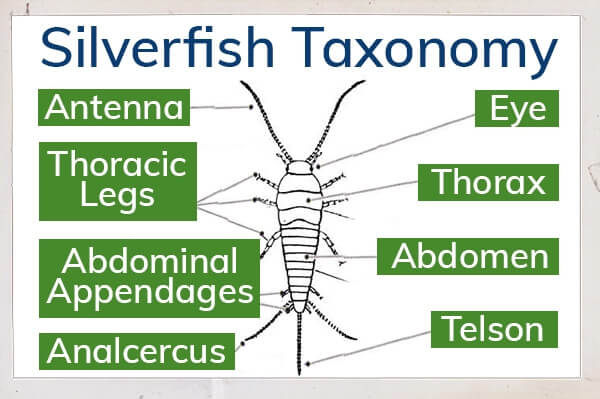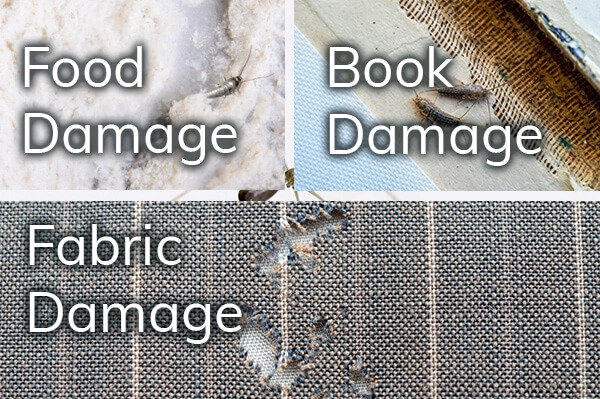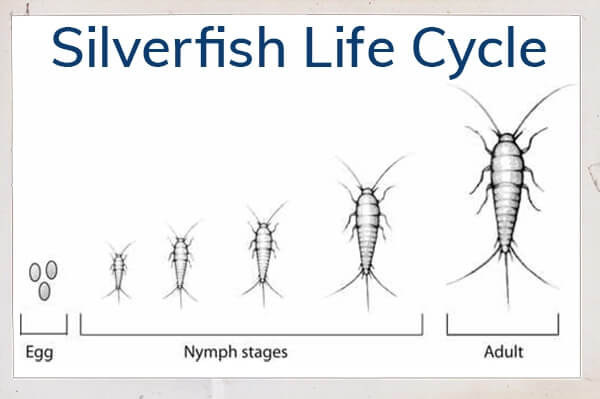Small, shiny, and often found scurrying around the moist spaces (bathrooms or under your kitchen sink) in your home, silverfish are sure to give any homeowner a fright. These pests enter your home through cracks and crevices in exterior walls and foundations, as well as through open doors or windows and they prefer to feast on starchy foods like cereal grains, flour, paper products, glue, heated pet food, sugar products, and more.
Once a silverfish infestation begins inside your home it can be difficult to control because the pests reproduce quickly and live for extended periods of time. So, in order to prevent an infestation from occurring inside your home it is important to keep all living areas dry by fixing plumbing leaks or reducing humidity levels throughout the house. Additionally it is beneficial for homeowners to inspect their property regularly for any signs of an infestation such as the small silvery scales they leave behind when shedding their skin or eggs cases near a potential food source. By understanding the dangers posed by silverfish and how they enter residential properties it is possible to avoid a silverfish invasion altogether. For those who already find themselves dealing with a silverfish problem, professional residential pest control services can help take back control of your home from these pesky pests once again!
Read on and learn all about these creatures, plus the steps you can take to keep them out of your property for good!
Silverfish appearance
Identifying silverfish is easy if you pay attention to the details of their appearance. Silverfish are small, silver-colored insects that usually measure up to about ¾ inch in length. Their bodies have a triangular shape, looking thicker at the front and tapering off towards the back, ending in two antennae-like appendages. On closer inspection, you will find that these creatures have three long bristles and two tail-like structures at the rear.

The adult silverfish tend to move around quickly and often dart away when disturbed, leaving behind a trail of scales or shed skin from its body as it moves around your home. They prefer to hide under furniture, carpets, baseboards and other areas of your house where they can escape detection. Unfortunately, their diet consists of numerous items found inside residential buildings such as starchy materials like wallpaper glue and book bindings which makes them difficult to get rid of. In addition to being able to recognize them by their physical characteristics mentioned above, you may also see signs of silverfish activity like shed scales and yellow stains from body fluids left behind on clothes or paper products throughout your home.
Are silverfish serious?
These tiny, wingless insects have a silver-gray color and a fish-like shape, giving them their unique name. Silverfish feed on organic substances like book bindings, glue, wallpaper paste, clothing, and fabric. As they move through the home looking for food sources to munch on, they can damage paper products, fabrics and other items around the house.
It is possible for silverfish to spread bacteria and other germs if they come into contact with food sources or other items that are frequently handled by people. Although their bites are generally not dangerous to humans, some individuals may experience allergic reactions from silverfish saliva or dust from their shedding skin. In terms of health risks due to illness transmission, it is important to remember that silverfish do not carry diseases or parasites that can be passed onto humans. However, residential pest control should still be considered as soon as silverfish infestations are detected in order to prevent long-term damage to property and possessions caused by their persistent chewing activities.

How do silverfish enter my home?
Silverfish have an incredible ability to fit their tiny bodies into incredibly small spaces and can be difficult to detect when entering residential properties and can exploit a wide array of entry points. Cracks, crevices, and gaps in foundations provide a vulnerable access point for silverfish to gain entry. Seals around doors and windows that have not been properly maintained may also allow for silverfish to squeeze through and find their way into your home. Additionally, silverfish have been known to travel inside on objects brought from outdoors, like boxes of newspapers or fabric.
To prevent silverfish from invading your home, it is important to inspect the exterior of your home regularly for potential entry points. Inspect walls, foundations, window seals, door frames and other points of potential access. Keep an eye out for any visible cracks or crevices that might be inviting silverfish in and seal any openings with silicone caulk or weather stripping if necessary. Additionally, take care when bringing objects into your home from outside as they could be carrying silverfish eggs or larvae that could hatch inside your residential property if left unchecked.
Types of silverfish in Southern California
There are three main types of silverfish that homeowners should be aware of in Southern California: the common silverfish, gray silverfish, and four-lined silverfish.
The common silverfish is generally light-brown in color with a flattened body shape and is usually between one-half to one inch long. It also has two long antennae on its head and three bristle-like tails at the end of its abdomen. This species is known for rapidly scurrying across floors and walls as it looks for food sources.
The gray silverfish is typically dark gray or blackish in color with a rounded body shape and grows up to one inch long. Unlike the common silverfish, this species moves more slowly but can still be seen lurking around residential properties looking for food or moisture. It also has two antennae on its head and three bristle-like tails at the end of its abdomen as well as tiny scales covering its body.
The four-lined silverfish is distinct from the other two species because it has four yellowish stripes running along its back from head to tail. This type of silverfish typically grows between ¾ – 1 inch in length, is wingless and can jump short distances when startled or threatened.
Homeowners should take extra precaution when dealing with these pests because they can reproduce quickly if left unchecked. Effective residential pest control methods such as exclusion techniques (making sure all windows/doors shut tightly) or chemical treatments can help reduce populations significantly when used properly.
Silverfish life cycle and reproduction
Silverfish have an interesting life cycle where they molt multiple times before reaching maturity. Females can lay a total of 200 eggs at once and the average batch size is around 50 eggs. Silverfish eggs are tiny, measuring only 1/25 inch long, and are usually found in crevices or buried within food such as cereals or pastas. The eggs can remain dormant if it’s cold outside and hatch up to six weeks later when the temperature rises. Upon hatching, silverfish will be a white color and lack scales, growing to around 1/16 inch long.
From there, silverfish then progress through various molts until they reach maturity. The length of time this process takes depends on the temperature – warmer environments cause silverfish to grow more quickly than cold ones do. When fully grown, these pests measure between ⅜ and ½ inch long with three tails at their rear. They live for about three years on average and reproduce by laying typically 50 eggs at a time, which repeat the same cycle as before.

Silverfish behavior and diet
Silverfish prefer moist, humid environments and are often found inside homes. Common residential areas for silverfish include laundry rooms, near water pipes, bathrooms, and basements. Silverfish are nocturnal creatures, meaning that they spend most of their time active at night. This behavior allows them to take advantage of food sources found in the dark.
The silverfish diet consists of mostly dry foods such as cereal, pasta, flour, dried meat, and other starchy substances like pet food and books. They can also digest fabrics due to an enzyme present in their bodies that helps break down these materials into smaller pieces so that they can be digested more easily. Silverfish have voracious appetites; a single silverfish can eat up to five times its body weight in a single day! In addition to providing nourishment for the silverfish itself, this diet also helps the silverfish reproduce quickly by providing it with the necessary sustenance to produce eggs at rapid rates.
Silverfish control
Preventing a silverfish infestation starts with basic residential pest control:
- Sealing any gaps in the foundation or exterior walls of your home
- Reducing the humidity levels in damp spots and
- Storing food items in air-tight containers
- Keeping an eye out for signs of silverfish activity such as small holes, yellow or brown stains on walls or paper products or shiny scales left behind from silverfish droppings
If silverfish have already set up shop in your home, there are a few different ways to get rid of them:
- Sticky traps
- Cedar oil
- Borax
- Dried bay leaves and
- DIY silverfish traps
You could also try newspaper bait and pesticides, but professional residential pest control services may be the best option to ensure complete removal. A pest control professional can identify potential problem areas around your home and provide superior treatments that protect your family and property from further infestations.
Contact us at 888-344-6567 or request a quote here AIPM to effectively handle any and all types of silverfish problems on your property. Keep your home clean, comfortable, and pest-free with AIPM’s comprehensive pest control services.
